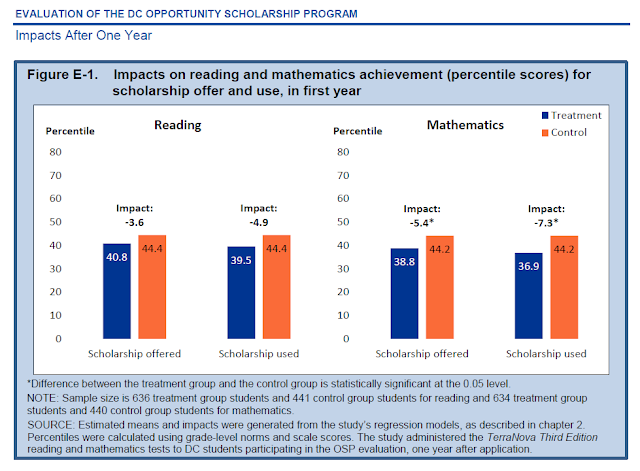"Throwing money at a problem" is a commonly used phrase for education reforms that do not yield positive results. The Trump administration is a big fan of the voucher system and in its proposed budget, more than a billion dollars will be added to support school choice. This increase comes with an overall decrease of nine billion dollars in the Department of Education's budget. This move comes even after Trump's own
Education Department reports on dismal results for the scholarship opportunity program in the District of Columbia.
 |
Above copied from
Dynarski, M., Rui, N., Webber, A., Gutmann, B. Evaluation of the DC Opportunity Scholarship Program: Impacts After One Year (NCEE 2017-4022). Washington, DC: National Center for Education Evaluation and Regional Assistance, Institute of Education Sciences, U.S. Department of Education. |
Trump administration's insistence to support school vouchers has earned the following
remark from Democratic senator Patty Murray:
"When Secretary [Betsy] DeVos’s own Department’s independent research office tells her that siphoning taxpayer dollars into private schools has a negative impact on students, it’s time for her to finally abandon her reckless plans to privatize public schools across the country,”
Having a "negative impact" certainly means "throwing money at a problem", but "siphoning taxpayer dollars into private schools" gives an additional meaning. Since funding education is limited, throwing money at failed vouchers also means taking money away from other educational programs that support students in public schools.
Vouchers are likewise gaining momentum in the Philippines. The government, as a matter of fact, is not capable of supporting its new K to 12 curriculum. As a result, the government relies on more than 4000 private schools to offer the additional two years in high school. For the first year of nationwide implementation of Year 11 in high school, the DepEd assigned 12 billion pesos.
It is now 2017, and last February, the
Business Mirror reported:
Although I did study algebra and even calculus, I am totally confused with the numbers. 3.95 billion is nowhere near 12 billion, and since these numbers are in the billions, the difference is truly astronomical. As school opens in a week in the Philippines, the second additional year of K to 12 will now be implemented nationwide. So simple math then dictates that twice the amount will need to be allotted for school vouchers. Sure enough, 24 billion pesos are alloted for vouchers in 2017:
The math behind the allotment looks simple. What is missing, of course, is how much the government is truly neglecting its obligation to provide quality basic education to its young. How the money is spent lacks transparency but worse of all, such waste of money demonstrates a complete lack of prioritization. Funding is sorely needed for the early years of basic education, kindergarten and elementary, and yet, the Philippine government continues to throw money at the problem and at the same time, take money away from where it is sorely needed.




Comments
Post a Comment